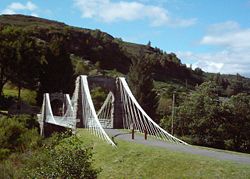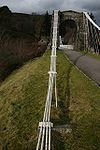James Dredge (1794)
| James Dredge | |||
 | |||
| The Bridge of Oich, Scotland | |||
| |||
| Born: | 1794 | ||
| Died: | 1863 | ||
| Operated: | Across the British Isles | ||
James Dredge
James Dredge (1794-1863) was originally a brewer in Bath in Somerset. However, by the 1840's he had turned his hand to engineering and designed a rather novel type of Suspension Bridge, which subsequently appeared in various parts of the country.
It is thought that he originally designed his first bridge as a direct route to get his beer across the River Avon, saving expenditure on the alternative - either a ferry or a long detour via the city centre and back.
It appears that there was another bridge engineer called James Dredge (1840-1906), who worked on several bridges in the London Area.
A Double Cantilever Bridge
Not a suspension Bridge
Technically, the bridges that Dredge designed are not Suspension bridges, but Double Cantilever bridges, where the continuous deck is supported by chains to create a structure which looks like a suspension bridge. To do this, Dredge patented his 'Taper Principle', which uses real chains, not cables like a suspension bridge. The patent was registered on 22nd July 1836, and the first bridge opened in December of the same year.
The Chains
If we consider a suspension bridge which has six hangers connecting the deck to the cables, and then look at how Dredge adapted this design. At the top of the traditional piers, we find twelve chains, each connected by lateral bolts at set intervals. As we descend to the first hanger point, the two outer chains descend to form the hangers. This process is then repeated until there are just two chains left for the final connection in the middle of the bridge.
The same principle works on the landward side of the piers, albeit with the chains becoming anchored in the ground about half way along their full equivalent length. In the example above that would be when only 6 chains remain.
The hangers were generally straight rods or bars, which dropped at different angles to support the deck more evenly.
The Benefits
In a Victorian world of horse and cart travel, the benefits were that much less material was needed to construct the chains, meaning that the bridge was lighter, most of the bridges were also constructed with timber decks. The rigid chain links also reduced the amount of sway in the bridge deck, and I only have to mention the Forth Road Bridge to demonstrate that ease of maintenance and longevity were further benefits.
On the Flip side, the bridges had a very low weight limit (approx 2 tons by modern standards), and while the principle could theoretically be scaled up, I don't think anyone has ever tried.
The Locations
Very little collated information seems to exist on exactly where these bridges were built or planned. Perhaps as many as 36 bridges were planned across Britain and Ireland, with more built in India. Not all of the locations are known, however the following sites have been identified:
- Artlington Court in Devon. Bridge Piers were built c1849, but the bridge was never completed.
- Balloch Bridge, Loch Lomond, Dunbartonshire, built in 1841, replaced late 19th Century.
- Ballievey Bridge, County Down. Collapsed under a lorry in 1988, replaced, surviving parts in storage.
- Birnbeck Pier, Weston super Mare, Somerset. Proposed scheme, not built.
- Bridge of Oich, A82, Inverness-shire. Built in 1854, closed to traffic, maintained by Historic Scotland.
- Glenarb Bridge, a footbridge built in 1844 over the Blackwater at Caledon, just north of the A28 in the counties of Tyrone and Armagh.
- Menai Suspension Bridge, Anglesey. Proposed reconstruction after damage in 1839. Not built!
- Moyola Footbridge in Castledawson, County Londonderry. Built in 1847, but now closed.
- Ness Islands, Inverness. The two suspension bridges that cross the River Ness via the Ness Islands were originally built to a variation of Dredge's patent design. However, both have been rebuilt in a more traditional manner since 1975. One of Dredges bridges was rebuilt nearby in Whin Park.
- Regents Park, London. There were apparently 5 bridges built to Dredge's design in Regents Park; all are now gone.
- Stowell Park Bridge, Kennet & Avon Canal, NW of Pewsey, Wilts. Private.
- Victoria Bridge, A830, Lochybridge, Fort William, Inverness-shire and Argyllshire. Replaced.
- Victoria Bridge, next to Homebase in Bath, Somerset. The first bridge, built in 1836, closed to traffic.
| Crossing | On Road | Opening Date |
|---|---|---|
| Ballievey Bridge | 1988 | |
| Bridge of Oich | A82 | 1854 |
Links
- Detailed analysis of Victoria Bridge, Bath PDF, 1.6Mb
- Graces Guide information on James Dredge and his bridges
| James Dredge (1794) | ||
| ||
|






